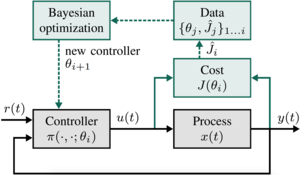Data-efficient Autotuning with Bayesian Optimization: An Industrial Control Study
2020
Article
ics
Bayesian optimization is proposed for automatic learning of optimal controller parameters from experimental data. A probabilistic description (a Gaussian process) is used to model the unknown function from controller parameters to a user-defined cost. The probabilistic model is updated with data, which is obtained by testing a set of parameters on the physical system and evaluating the cost. In order to learn fast, the Bayesian optimization algorithm selects the next parameters to evaluate in a systematic way, for example, by maximizing information gain about the optimum. The algorithm thus iteratively finds the globally optimal parameters with only few experiments. Taking throttle valve control as a representative industrial control example, the proposed auto-tuning method is shown to outperform manual calibration: it consistently achieves better performance with a low number of experiments. The proposed auto-tuning framework is flexible and can handle different control structures and objectives.
| Author(s): | Matthias Neumann-Brosig and Alonso Marco and Dieter Schwarzmann and Sebastian Trimpe |
| Journal: | IEEE Transactions on Control Systems Technology |
| Volume: | 28 |
| Number (issue): | 3 |
| Pages: | 730--740 |
| Year: | 2020 |
| Month: | May |
| Department(s): | Intelligent Control Systems |
| Research Project(s): |
Controller Learning using Bayesian Optimization
|
| Bibtex Type: | Article (article) |
| Paper Type: | Journal |
| DOI: | 10.1109/TCST.2018.2886159 |
| State: | Published |
| Links: |
arXiv (PDF)
|
|
BibTex @article{NeuMarSchTri18,
title = {Data-efficient Autotuning with Bayesian Optimization: An Industrial Control Study},
author = {Neumann-Brosig, Matthias and Marco, Alonso and Schwarzmann, Dieter and Trimpe, Sebastian},
journal = {IEEE Transactions on Control Systems Technology},
volume = {28},
number = {3},
pages = {730--740},
month = may,
year = {2020},
doi = {10.1109/TCST.2018.2886159},
month_numeric = {5}
}
|
|



